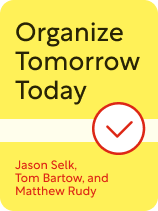

This article is an excerpt from the Shortform book guide to "Organize Tomorrow Today" by Jason Selk, Tom Bartow, and Matthew Rudy. Shortform has the world's best summaries and analyses of books you should be reading.
Like this article? Sign up for a free trial here.
What is Organize Tomorrow Today about? What is the key message to take away from the book?
If you often find yourself overwhelmed by your task list and obligations, Organize Tomorrow Today can help. You’ll learn how to increase your productivity by prioritizing, preparing for, and executing your tasks every day.
Below is a brief overview of the key takeaways from Organize Tomorrow Today: 8 Ways to Retrain Your Mind to Optimize Performance at Work and in Life.
Organize Tomorrow Today: 8 Ways to Retrain Your Mind to Optimize Performance at Work and in Life
In Organize Tomorrow Today, Matthew Rudy, authors Jason Selk and Tom Bartow teach you how to increase your productivity, maximize your time, and set yourself on the path to success.
Combining backgrounds in athletics, psychology, and finance, Selk and Bartow have worked for decades as advisors and coaches in both the sports and business worlds. Their programs have helped countless athletes and business professionals improve their job performance and become some of the most successful members of their fields.
In this guide, you’ll learn how to:
- Improve your life by building positive habits
- Evaluate your daily progress
- Communicate effectively with yourself and others
In our commentary, we’ll touch on other authors’ advice for improving your productivity and examine some of the science behind Selk, Bartow, and Rudy’s strategies.
Increase Your Productivity
In this section, we’ll discuss how Selk, Bartow, and Rudy argue that you can set yourself up for maximum productivity every day. You’ll learn the authors’ strategies for prioritizing tomorrow’s most important tasks and preparing your mind for optimum performance. We’ll also explore their advice for limiting the time you spend on unproductive and unnecessary tasks.
Strategy #1: Write and Prioritize Your To-Do Lists a Day in Advance
Selk, Bartow, and Rudy suggest you take time every day to write a to-do list of the tasks you need to accomplish the next day. Instead of writing a long list of everything you want to get done in the near future, limit tomorrow’s to-do list to the three most important items you need to finish.
Planning for and prioritizing your most important tasks a day in advance helps you start your day with clarity about where to place your efforts. This will build your confidence and reduce your anxiety about failing to get everything done.
The authors note that what’s most useful and important to get done will look different for everybody. Whatever the tasks are, they should give you forward momentum in your day, in your projects, and in your general path to success. For example, these tasks could be setting up important meetings, making phone calls to clients, sending outreach emails, practicing for a big presentation, planning for an event, and so on.
How to Write Your Three-Item To-Do List
When you write your three-item to-do list, the authors advise that you don’t write down full projects—choose individual tasks that can realistically be finished in a single workday. For example, a project might be planning a big work event, and a task involved in that project (and a potential item on your to-do list) could be sending out invitations.
Choose one of the three tasks you wrote down and label it as the most important. This should be something that you have to do tomorrow no matter what. Before you do anything else the next day, complete the most important item on your three-item to-do list.
Selk, Bartow, and Rudy argue that choosing one item to start with makes you more likely to take action to complete it. Once you get started on the first task, your momentum will carry you forward, and it’ll be easier to complete the other to-do list items.
Try to complete all three tasks early in the day. Once you finish the three priority tasks, you can spend the rest of your day completing any other tasks you want.
Strategy #2: Prepare Your Mind for Success
Selk, Bartow, and Rudy also offer a technique to help you mentally prepare for the day or the task ahead. Just like it takes work to keep your physical body healthy, it takes time and effort to keep your mind healthy. The authors’ exercise only takes about two minutes to complete, and it helps to foster a sense of peace and positivity as you move forward in your day.
Step 1: Take a Calming Breath
Start the mental preparation exercise with a calming breath. Inhale and exhale deeply, pausing for a couple of seconds between breathing in and breathing out. According to the authors, this improves your mental state because focused breathing reduces the effects of your body’s stress response. Since its stress response hinders your ability to think clearly, a calming breath will help clear your mind.
Step 2: Repeat Positive Affirmations About Who You Want to Be
According to the authors, the next step is to repeat affirmations that define qualities you want to embody. Create your affirmations by focusing on the things you desire. Start with the phrase, “I am…,” then name the positive qualities you want to embody. For example, you could say, “I am kind to the people around me. I am a hard worker and full of creative ideas. I am present for my friends and family.” By repeating the statements frequently, you help turn them into reality.
Step 3: Visualize the Previous Day’s Successes and Tomorrow’s Tasks
During this step of mental preparation, the authors suggest you start by picturing three moments of success from the day before. This will remind you of your ability to succeed and reinforce your positive mindset. Then, picture three things you want to get done in the next 24 hours. Picture yourself performing the tasks successfully, and imagine how you want to feel. The more detailed your visualization is, the more helpful it’ll be.
Visualization prepares your mind and body for an action before you really take it. It allows you to rehearse what you want to happen, meaning by the time you have to do the thing you visualized, you feel more prepared for potential challenges and surprises.
Step 4: Repeat the First Two Steps
To finish your mental preparation exercises, the authors suggest repeating the first two steps in reverse order. First, repeat the positive affirmations you came up with for Step 2. Then, finish by taking another calming breath.
Strategy #3: Limit Windows of Time Spent On Unproductive Tasks
The authors suggest establishing a maximum amount of unscheduled time you can use for unproductive tasks before you have to start working on your to-do list items. When you start to fill these smaller gaps in your day by completing productive tasks instead of wasting time, you’ll see your overall productivity increase substantially.
For example, say you give yourself a maximum of 10 minutes in between scheduled events to spend on unproductive tasks. If you get out of a meeting five minutes before the next item on your schedule, you can spend that time chatting with coworkers, scrolling on your phone, and so on because it’s under your 10-minute threshold. However, if you get out of a meeting 15 minutes before the next item on your schedule, you have to spend that time working on your to-do list because it’s over the threshold.
Strategy #4: Shorten Tasks and Eliminate the Unnecessary
Finally, you can increase the amount of time you have to spend on important tasks by re-evaluating the items you already have in your schedule. The authors offer the following tips for doing this effectively:
Set a time limit for every activity on your calendar, and stick to it. Always begin on time, and move on from the activity when your time runs out. Your efficiency will naturally improve when you have a clear beginning and end time for each task because you’ll work more quickly to ensure you finish your tasks within the set amount of time. By contrast, if a task has no set end time, you can procrastinate on it indefinitely because there’s no rush.
Get rid of unnecessary meetings, and shorten the ones you have to keep. If the work you plan to do during a meeting could be completed in a more efficient way (for instance, via a short email thread), cancel the meeting.
Build Positive Habits
In the last section, you learned Selk, Bartow, and Rudy’s advice for increasing productivity by prioritizing your tasks, preparing your mind for success, and making the most of your time. In this section, you’ll learn how to spend some of the time you save thanks to your newfound productivity on creating and keeping positive habits.
How Habits Work
According to the authors, habits are patterns of behavior that become more or less established in your daily life depending on how often you engage in the behavior. The authors state that if you frequently reinforce a habit through your choices, it’ll get stronger. If you engage in the behavior less frequently, the habit will get weaker.
If a behavior feels good, you’ll want to repeat it, and this repetition forms a habit. As time goes on, your brain incorporates the habit into your regular activity. You end up doing it without thinking, even if it doesn’t ultimately serve you.
For example, maybe you have a busy day at work, and you have to stay late at the office. You were going to cook when you got off work, but you’re too tired, and you decide to get takeout on the way home. Once you have your food, you’re happy—it tastes good, involves little clean-up, and required minimal effort to acquire. As the weeks go on, you’re still busy at work, and you find yourself getting takeout more and more. Once it turns into a habit, your brain expects the reward, and you’re barely cooking at all.
Be Consistent and Keep Going When It’s Hard
The authors argue that although we often start habits without realizing it, we can also consciously start new habits to make positive changes in our lives. For example, if you want to learn another language so you can travel to a new country, you may decide to practice the language for an hour every day.
Unlike the habits we fall into by accident, conscious habits take work to maintain. Even though the behavior will help you make positive changes in your life, you may not always feel like doing it. To keep a positive habit, the authors argue that you must push forward and maintain the behavior even when it becomes difficult.
The authors offer a few tips for increasing your chances of successfully starting and maintaining a healthy habit:
Tip #1: Always Do the Habitual Behavior at the Same Time of Day
Selk, Bartow, and Rudy suggest picking a time for your habitual behavior and forcing yourself to do it at that time every day. By designating time for your habit beforehand, you’re removing the option to not engage in the behavior and avoiding the temptation to procrastinate. For example, if you want to start cooking dinner at home every evening, build cooking into your daily schedule and make sure you’re in the kitchen at that time no matter what.
Tip #2: Acknowledge When You’re Struggling
If you ever feel like skipping your positive habit, the authors argue that you should acknowledge that feeling. To work through a struggle, you first have to recognize that it’s happening. Additionally, every time you recognize a challenge and then overcome it, your success will trigger pride and positive momentum to tackle the next challenge that comes.
Tip #3: Look Ahead
Selk, Bartow, and Rudy suggest imagining how your life will be different five years from now if you keep going with your new habit. Visualize this future in as much detail as possible. Then, imagine what your life will look like if you abandon your healthy habits. This will remind you why you want to make this change for yourself and what you’ll miss out on if you don’t.
Common Challenges to Habit Maintenance
Once your new habit is a part of your daily routine, you may feel like the hard part is over. However, the authors warn that you should still be aware of factors that might tempt you to break your habit. When you recognize your personal set of challenges to your good habits, you can better address them as they appear. Here are some common circumstances that lead people to break habits:
Circumstance #1: Interruptions to Your Routine
According to the authors, special circumstances like sickness and holidays can change your daily routine. When these circumstances interrupt your routine, you may pause your habitual behavior out of necessity. However, since habits require consistency to remain strong, a prolonged pause can make it difficult to return to the same pattern of behavior right away.
For example, let’s say you normally practice a second language on a learning app every evening, but then you take a two-week-long vacation and don’t practice at all during your time off. When you return to everyday life, you may find it difficult to get back into the habit of studying the language because the behavior is no longer automatic.
Circumstance #2: Slow Results
Another factor that may threaten your habit is discouragement. The authors assert that sometimes, the positive results you expect to see after starting a new habit won’t be immediately apparent. Don’t let this discourage you—you’re still succeeding just by making a positive change for yourself.
Circumstance #3: Overconfidence
Finally, some people who experience a high level of success with their new habit think they can stop working as hard to maintain it and still achieve the same results. You may be able to get by with less effort for a little while, but the authors argue that in the long term, your reduced effort will undermine the positive effects of the changes you made. You’ll see a decrease in your progress, and you’ll have to go through the whole process of starting the habit again.
When you feel the temptation to put in less effort, the authors advise you to do the opposite: Put in more effort toward your habit that day. You’ll show yourself that you’re committed and strong and that you can overcome challenges most people can’t. This will motivate you to keep going. For example, if you normally take a daily walk, but you don’t feel like doing it one morning, don’t stay in bed—add an extra mile to your route instead.
Keep Track of Successes and Areas for Improvement
In the previous section, you learned how to improve your life by starting and maintaining positive habits. In this section, we’ll discuss Selk, Bartow, and Rudy’s advice on how to keep track of these improvements, along with potential areas of needed growth. To do this effectively, you’ll learn how to break free from a perfectionist mindset and constructively evaluate your progress every day.
The Dangers of a Perfectionist Mindset
The authors assert that assessing what you’re doing well and what you can improve on is an important step toward success. However, many people do this ineffectively because they assess themselves with a perfectionist mindset. They focus only on their shortcomings and ignore their accomplishments.
To combat perfectionism, practice giving yourself credit when you deserve it. Don’t just focus on your mistakes—acknowledge the things you do well. Positive reinforcement is a much better motivator than negativity. Additionally, measure your success by the effort you put in, not by the results you achieve. If you do everything you can to reach your goals, that’s an achievement in itself.
Strategy: Keep a Daily Record of Your Progress
To help you focus on what you’re doing well as well as the ways you can improve, the authors recommend writing an evaluation of your progress every day. You can refer back to the successes you’ve recorded whenever your confidence needs a little help.
You should center your evaluation around the daily tasks you’ve completed:
Step 1: At the same time every day, write down three things you did well in the last 24 hours and one thing you can do better in the next 24 hours.
Step 2: Write down one action you can take to make the improvement you identified in Step 1.
Step 3: Give yourself a rating from one to 10 based on how well you completed the three prioritized tasks on your to-do list.
Communicate Effectively With Yourself and Others
In the previous section, we explored the problematic nature of perfectionism and learned a strategy for daily self-evaluation. In this final section, you’ll learn another of Selk, Bartow, and Rudy’s strategies for breaking free from limiting mindsets: constructive self-communication. We’ll also discuss how to effectively communicate with others, especially when presenting information.
Eliminate Negativity in Conversations With Yourself
The authors assert that one of the biggest determiners of success is the way you speak to yourself. If you consistently talk to and about yourself with negativity, you’ll view yourself negatively. A negative self-image will hamper your ability to perform successfully—you can only perform up to the level you believe you can.
To begin combating negative self-talk, first, recognize how you communicate with yourself. When you see negative thoughts about yourself for what they are, you can begin separating them from your self-image. As negative thoughts about yourself arise, stop them by setting a rule that you’re not allowed to speak to yourself that way.
Additionally, instead of focusing on the problems that might hinder your success, focus on the solutions you can use to improve things. When you center your thinking around problems, they become bigger in your mind, and you make decisions based on fear.
For example, if there’s something you don’t understand at work, don’t focus on thoughts like, “I’m not smart enough to do this,” or “I don’t belong here.” Instead, consider possible solutions, like finding resources you can use to research your question or thinking of people you can ask for help.
Present Information With Confidence
Your overall success in work and life will also depend on how well you communicate with others. According to the authors, being knowledgeable means nothing unless you’re able to convey information effectively. Luckily, effective delivery of information is a skill you can practice and master.
The authors offer two main strategies you can use to improve your outward communication skills, particularly when giving presentations:
Strategy #1: Limit Yourself to Only the Most Important Points
When you’re giving a presentation, don’t overload your audience with excess information. According to the authors, we can only hold a limited number of ideas in our minds at any one time. Therefore, if you introduce too many points, your audience will likely forget or miss several of them. Additionally, the more ideas you present, the more you’ll have to explain, possibly creating unnecessary confusion.
To avoid delivering an overloaded presentation, write a concise script beforehand. Determine what your most important points are, and cut everything else. Here are some steps the authors recommend you take when producing a script:
Step 1: Plan the first five minutes of your presentation. Then, read through your script and eliminate any information that isn’t essential to making your main points.
Step 2: Plan the last five minutes of your presentation. Planning the end will help you figure out what steps you need to take to get there. As in Step 1, remove any unnecessary information from your script.
Step 3: Map out the essential content of your presentation between the beginning and end, and make sure that each point leads to the conclusion you planned in Step 2.
Step 4: Add anecdotes that support your points to create memorable connections for your audience and establish your credibility.
Strategy #2: Practice Your Presentation With Intention
According to Selk, Bartow, and Rudy, the most effective communicators are confident and poised, and you can build your confidence by practicing properly for presentations. We’re usually more afraid of things when we feel unprepared for them, so the more you practice, the more confident you’ll feel. To practice your delivery, the authors recommend rehearsing your presentation for three minutes, three times per day, for three days before you have to present.
As you rehearse, practice what you want to say and how you want to say it. As you practice your delivery, try to speak slowly and add meaningful pauses. When you’re giving a real presentation, this will make you seem more confident, and it’ll give your audience a chance to process the information you give them. Practicing both content and delivery will put you in the right mindset for the real thing.

———End of Preview———
Like what you just read? Read the rest of the world's best book summary and analysis of Jason Selk, Tom Bartow, and Matthew Rudy's "Organize Tomorrow Today" at Shortform.
Here's what you'll find in our full Organize Tomorrow Today summary:
- How to prioritize and prepare for your tasks every day
- How you can improve your life through positive habits
- Why you need to break free from a perfectionist mindset






